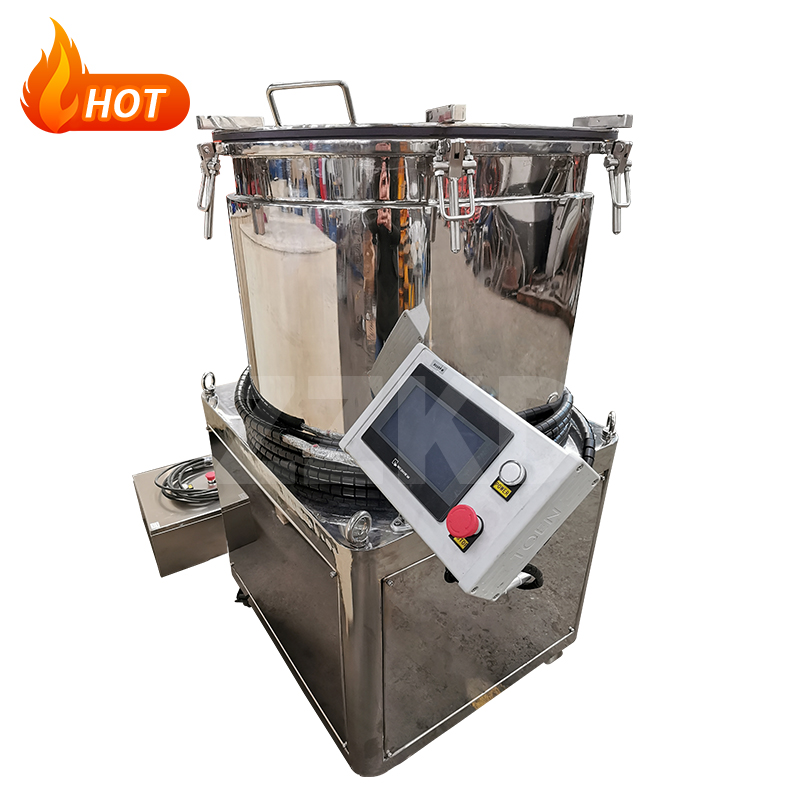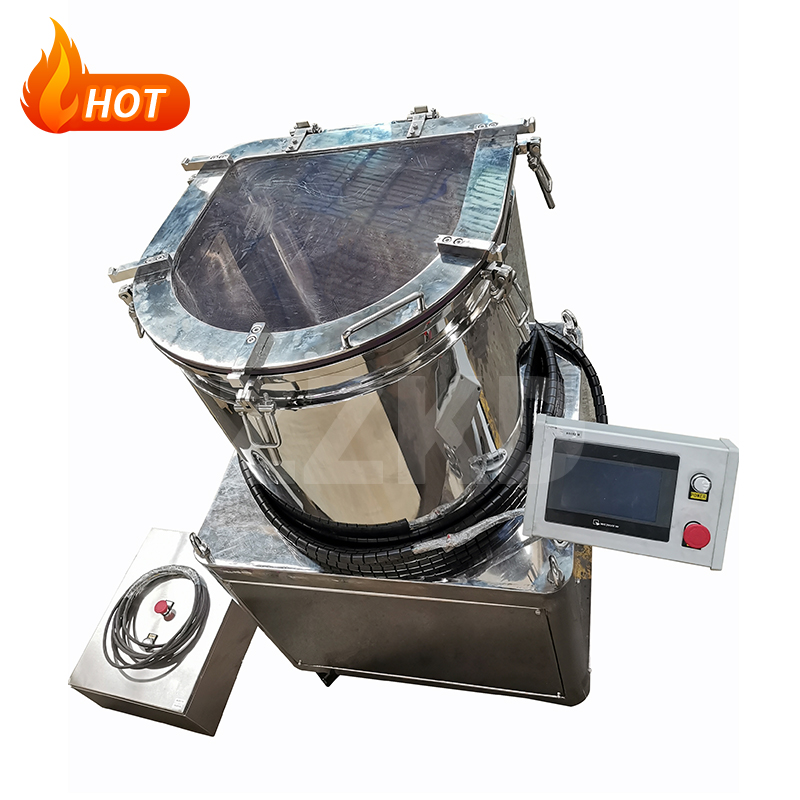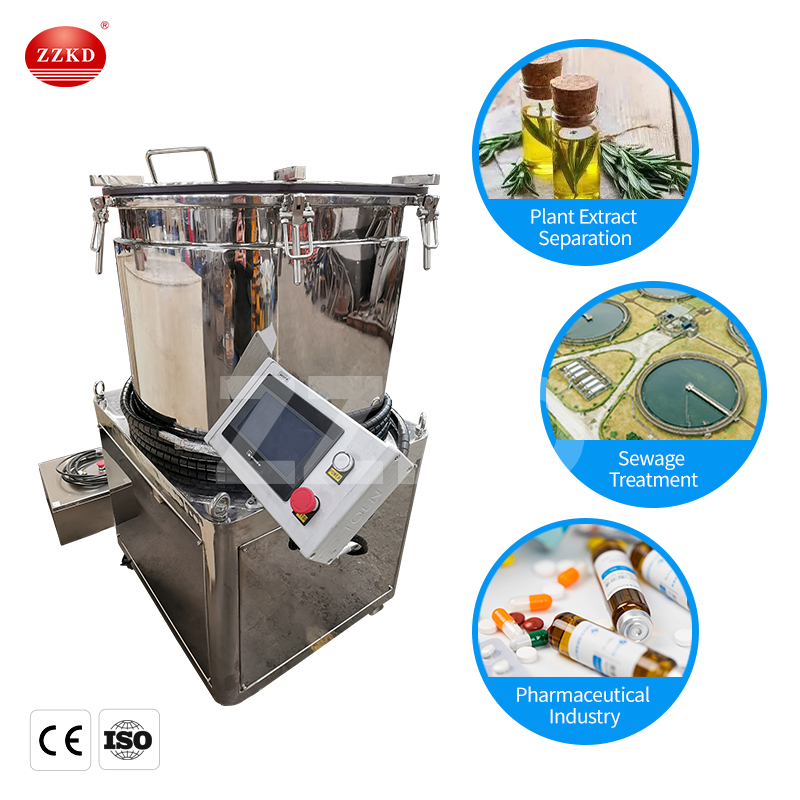How Does An Industrial Centrifuge Work
The stainless steel centrifuge is a kind of separation machine whose function is to separate the mixed liquid (liquid and liquid) of solid and liquid, so as to obtain solid and liquid (or liquid and liquid) respectively. Natural stratification occurs when the density mixture is left to stand, the solid generally settles to the bottom layer, and the upper layer forms a clear liquid. Layering relies on the gravitational acceleration of the earth. In order to meet the needs of industrial production, people need to separate certain mixed liquids faster and more, thus resulting in centrifuges. Let's take a look at how does an industrial centrifuge work.

How does an industrial centrifuge work:
1. Open the centrifuge lid.
2. Assemble the centrifuge tube as required.
3. Install the centrifugal rotor as required.
4. Close the centrifuge lid.
5. Input the centrifugation data and edit the centrifugation program.
6. Evacuate and start running the program.
7. At the end of the program, go to the vacuum.
8. Open the centrifuge lid and remove the rotor.
9. Remove the centrifuge tube and analyze
The above are the working steps of the centrifuge. The centrifuge rotates at a high speed to generate a strong centrifugal force. Therefore, a variety of centrifuges of different specifications are formed. Generally, the speed of the centrifuge for separating solids and liquids is below 3000 rpm, and the mixture with finer particles and smaller density difference requires centrifugation between 8,000 and 30,000 rpm. centrifuges, while enrichment separations like uranium require higher-speed centrifuges.

A centrifuge is a machine that uses centrifugal force as a power and uses a centrifugal field to separate the suspension liquid from the liquid. Centrifuges are prone to malfunction under long-term use or improper operation. As we all know, industrial endoscopes, as non-destructive testing equipment, are very effective in detecting mechanical equipment failures. So pay attention to the maintenance of the centrifuge.
Use and maintenance of the centrifuge:
The centrifuge is running at high speed when working. Pay attention to safety when using it. You must do the following:
1.The centrifuge should be placed on a stable and sturdy table (its base is equipped with rubber suction feet, which are close to the table by means of atmospheric pressure and the weight of the instrument itself); large-capacity low-speed centrifuges and high-speed refrigerated centrifuges Place accordingly on firm ground, level. The ultracentrifuge weighs hundreds of kilograms and should be placed on a solid ground with dust-proof and moisture-proof equipment to ensure that the centrifuge chamber can reach a certain degree of vacuum and operate normally. Before the centrifuge works, the load should be balanced, and the smaller the weight error, the better, otherwise it will cause severe vibration and damage the centrifugal rotor and shaft.
2. The centrifuge separation support must be run after placing the centrifuge tube, and it is strictly forbidden to run empty. When the centrifuge is started, the speed switch or the high value knob should be placed in the low gear, and then gradually adjusted to the required value after starting. After one operation, the knob must be adjusted to a low gear to work again, and direct start is prohibited in a high-speed gear or a high-value gear.
3. Select a suitable rotor and control the speed of the rotor. The maximum speed of the rotor should be reduced in the following cases: when the operating time and number of operations of the rotor reach the specified life; when the rotor is damaged by local surface damage or slightly corroded in the tube hole; stainless steel centrifuge tubes, casings, Thick-walled tubes or centrifuge bottles; When the average density of the sample exceeds 1.2g/cm3; When the rotor is subjected to high temperature.
4. The rotor should be strictly checked for foreign matter and dirt in the hole before each use to maintain balance. The rotor must be kept dry and clean, and must not be bumped or scratched. In case of accidental fall, the turning head should be checked by X-ray to confirm that there is no internal damage before continuing to use it. After each use, the rotor should be soaked and cleaned with warm water (50℃~60℃) and neutral detergent, and finally rinsed with distilled water or deionized water, dried with a soft cloth, dried with a hair dryer, waxed, and stored dry.

5. The tensile strength and elongation of various centrifuge tubes are different and should be selected according to needs. When using, ensure that samples, solvents and gradient materials do not corrode the centrifuge tube and cap components. Expired, aged, cracked or corroded centrifuge tubes should not be used or used at a reduced speed. Control the number of times the plastic centrifuge tube is used, and pay attention to the matching specifications. Do not open the centrifuge chamber cover during centrifugation, and do not hit the rotating rotor and centrifuge tube with your hands or foreign objects.
6. For low-temperature centrifugation samples, the empty rotor should be pre-cooled at 2000 rpm for a certain period of time, and the temperature should be controlled at about 0 °C during pre-cooling. The rotor can also be pre-cooled in the refrigerator for several hours for use. The centrifuge cup can be stored directly in Pre-chill in refrigerator.
7. If abnormal phenomena are found during the centrifugation process, such as abnormal noise and vibration, it should be stopped immediately for inspection, and the operation should not be continued until the cause is found.
8. In the process of daily use of the centrifuge, the level of the host should be corrected every three months, and the vacuum pump oil should be processed once every 500 million revolutions, and the carbon brush of the drive motor should be checked after 500 hours of operation. It is best to use a vacuum cleaner to remove the carbon powder produced by friction. Remove, if necessary, replace the carbon brush or polish the commutator with fine sandpaper. Every 1500h or so of use, the bearing of the drive part should be cleaned and high-speed lubricating grease should be added. The joint part of the rotating shaft and the rotor should be greased frequently to prevent rust. When not in use at ordinary times, it should be turned on at a low speed 1-2 times a month, 0.5h each time, to ensure the normal operation of all parts.


